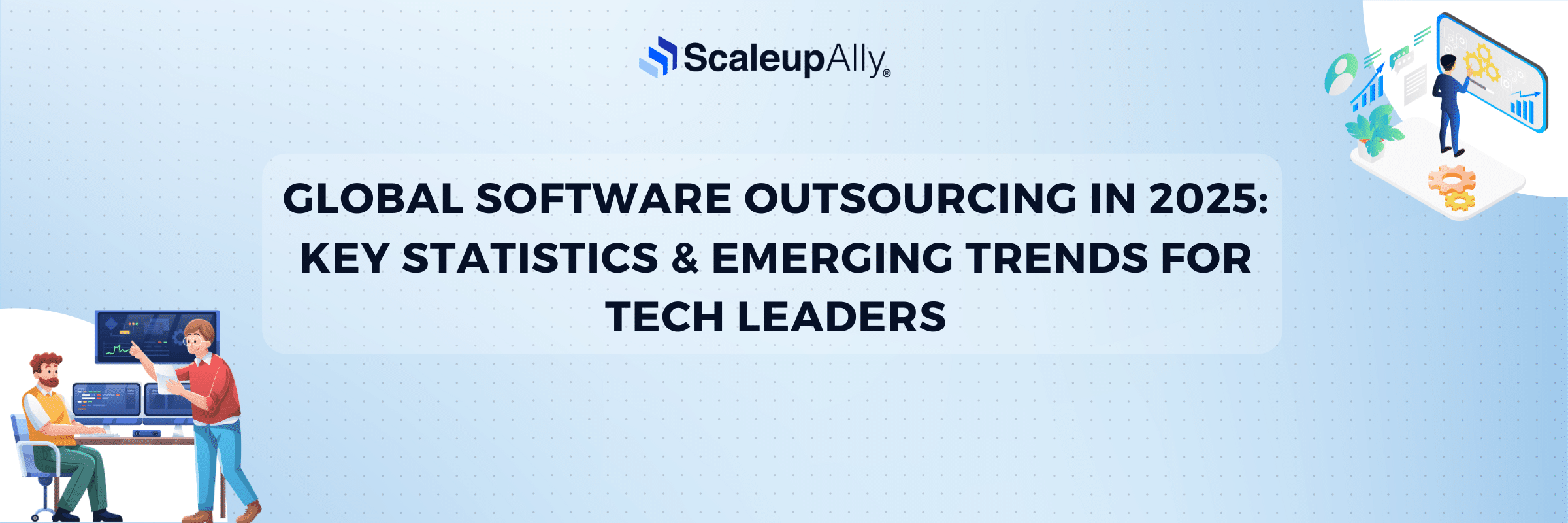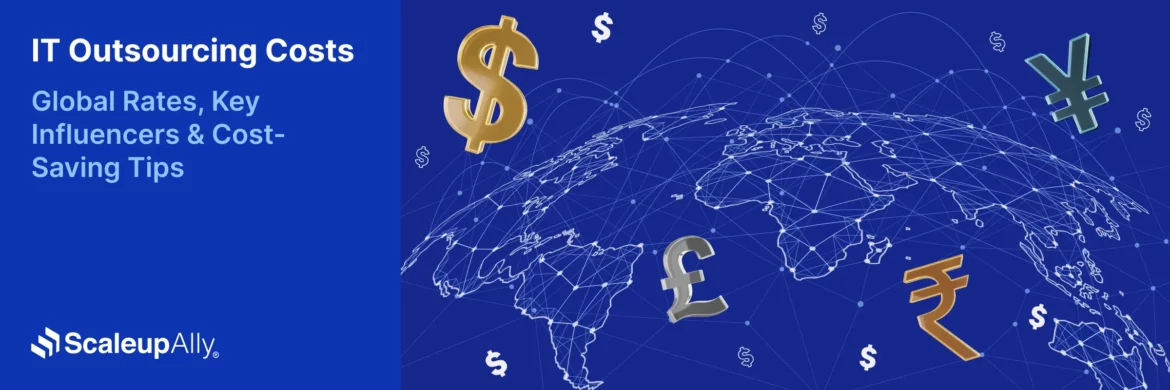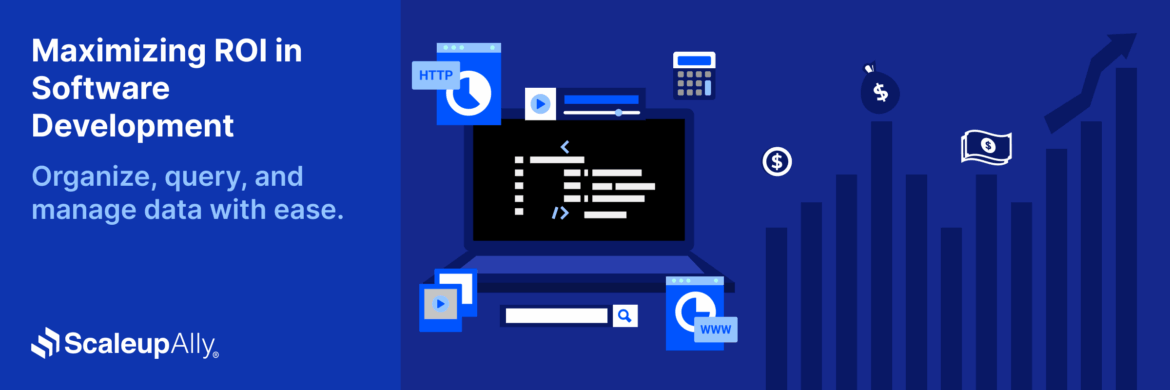
Global Software Outsourcing in 2025: Key Statistics & Emerging Trends for Tech Leaders
Pranay Agrawal | June 28, 2025 , 9 min read
Table Of Content
The global IT software outsourcing market’s revenue is set to reach US$651.54bn in 2025, according to Mordon Intelligence. And while CTOs debate whether outsourcing threatens their in-house teams, the reality is that 64% of IT leaders globally are choosing to outsource, and they’re saving tens of thousands per year doing it.
However, most conversations about global software outsourcing focus on the money saved instead of the velocity gained. Businesses can tap into a global talent pool of over 500,000 specialized developers and accelerate time-to-market by up to 50%. That half-year advantage is the difference between launching before your competitor or watching them dominate the market you thought was yours.
Yet most discussions around outsourcing still sound like they’re happening in 2015. The landscape has evolved past simple labor arbitrage into something far more complex and valuable. The companies winning in 2025 understand this. The ones still debating whether to outsource? They’re already behind.
In this blog, we explore 2025’s top global software outsourcing stats, key trends, and insights to optimize your outsourcing strategy and stay ahead of the curve.
Key Takeaways
- Global software outsourcing is projected to reach $591 billion in 2025, with 64% of IT leaders already outsourcing and saving up to $77,688 annually.
- 40% of CTOs now say outsourcing is “needed” (not just useful), while companies gain 40-50% faster time-to-market through external partnerships.
- 80% of North American companies are considering nearshore options for better time zone alignment and cultural compatibility.
- Nearly 80% of outsourcing firms are adopting AI tools by 2025, making development faster and more efficient than traditional methods.
- 78% of businesses report positive outsourcing experiences, with better project outcomes and faster delivery times than internal development.
Top Global Software Outsourcing Statistics in 2025
Here are the top global software outsourcing statistics reshaping how companies build technology in 2025.
1. Market Size Reality Check
The global IT outsourcing industry surpassed over $540 billion in revenues in 2024. But that figure understates the velocity of change. The global revenue in the IT Outsourcing market was estimated to continuously increase between 2024 and 2029 by in total of 271.7 billion U.S. dollars (+50.22 percent).
Here’s what makes those numbers fascinating: the United States will dominate the market, generating the highest revenue of US$218.02bn in 2025, per Statista data. That’s nearly half the global market controlled by American companies, despite them outsourcing to other countries.
2. Success Metrics That Matter
78% of businesses report positive experiences with their outsourcing providers, citing better project outcomes, faster delivery times, and access to expert knowledge. That satisfaction rate contradicts the narrative that outsourcing equals compromised quality.
3. Growth Trajectory Through 2025
In the period from 2023 to 2027, the revenue of software outsourcing is forecasted to thrive at a CAGR of 7.54%. But growth isn’t uniform across all outsourcing models.
By 2025, 60% of businesses would not renew their existing BPO contracts due to outdated pricing practices, Gartner predicts. That suggests a massive reshuffling of vendor relationships is coming.
4. Executive Sentiment Shift
Perhaps the most telling statistic: 40% of CTOs share the opinion that software development outsourcing is needed, Orient Software reports. Not preferred, not cost-effective, but needed.
The data reveals something the industry discussions often miss: global software outsourcing has evolved beyond a cost play into a capability expansion strategy that most technology leaders now consider essential rather than optional.
Latest Global Trends in Software Outsourcing in 2025
The landscape of global software outsourcing is shifting faster than most executives anticipated. What worked last year feels outdated, and what’s emerging challenges conventional wisdom about how companies should structure their technology partnerships.
1. AI-Powered Development Acceleration
Nearly 80% of outsourcing firms are expected to adopt artificial intelligence solutions by 2025. This is amplifying the capabilities of developers exponentially.
AI-powered tools, such as GitHub Copilot and Tabnine, aid developers in generating code snippets and recommending improvements in real time. Predictive analytics tools, automated testing, and coding assistants have become standard in the software outsourcing industry trends for 2025.
The productivity gains are staggering. Code generation that once took hours now happens in minutes, and bug detection happens before deployment rather than after customer complaints.
2. Cloud-First Outsourcing Architecture
The migration to cloud computing is accelerating, with nearly 80% of companies increasing their digital initiatives in the past two years, a trend projected to drive IT outsourcing growth through 2025.
Cloud-based outsourcing enhances data security and privacy using robust data encryption, secure data centers, and extensive access control measures.
Companies are discovering that cloud-native outsourcing relationships offer flexibility impossible with traditional hosting models. Scale up for launches. Scale down during quiet periods. Pay for what you use.
3. Nearshore Dominance Over Offshore
The pendulum is swinging hard toward proximity. 80% of companies in North America are actively considering nearshore outsourcing, Bloomberg reports. The Latin American market is projected to grow at a CAGR of 12.7% from 2025 to 2030.
Nearshore outsourcing is gaining traction due to time zone and cultural compatibility. Similar time zones mean real-time collaboration, and cultural alignment reduces miscommunication costs.
4. Cybersecurity-Centric Partnerships
In 2025, cybersecurity outsourcing will be more than just regular security services. It will focus on cloud security, AI-driven threat monitoring, and safe software development practices.
In 2025, companies will increasingly outsource cybersecurity, AI/ML development, cloud infrastructure management, software development, and IT support.
Security isn’t an afterthought anymore. It’s the foundation of every outsourcing contract. Companies are realizing that external partners often have better security expertise than internal teams.
5. Staff Augmentation Over Project Handoffs
Instead of fully outsourcing entire projects, companies are increasingly opting for IT staff augmentation. This reflects hard-learned lessons about project ownership. Companies want external expertise integrated into their teams, not isolated from them. The result? Better knowledge transfer and reduced project handoff risks.
6. Automation-First Process Design
Companies are investing heavily in AI and Robotic Process Automation (RPA) technologies to streamline processes and enhance efficiency.
From automated model training and optimization to intelligent error detection and resolution, AI-powered automation tools are reshaping the future of software development outsourcing.
Manual processes that defined outsourcing relationships for decades are disappearing. Automated deployment pipelines, intelligent testing frameworks, and self-healing systems are becoming standard expectations.
7. Specialized Skills Over Generalist Teams
Trends such as offshore outsourcing, specialized skills, and automation are driving market evolution. Companies are moving away from “full-service” providers toward specialists who excel in specific technologies or domains.
The generalist approach worked when technology stacks were simpler. Today’s complexity demands expertise depth over breadth.
8. Data Privacy as Competitive Advantage
Major challenges include data security, compliance with regional regulations, Coherent Solutions notes. But forward-thinking companies are turning compliance challenges into competitive advantages.
Providers who can navigate GDPR, CCPA, and emerging privacy regulations seamlessly are commanding premium rates. Data protection is a revenue driver.
9. Generative AI Integration
Generative AI creates new content, boosts creativity, and problem-solving in fields like entertainment and healthcare. In 2025, nearshore IT outsourcing will continue to grow, driven by the increasing demand for AI-driven development, automation, and secure cloud solutions.
The creative potential of generative AI is reshaping what’s possible in global software outsourcing. Code generation, documentation creation, and even UI design are becoming collaborative efforts between human developers and AI systems.
Conclusion
The statistics don’t paint a future scenario. They document a present reality most companies haven’t fully grasped yet.
The $591 billion flowing through global software outsourcing in 2025 represents more than market size. It represents collective intelligence that companies like yours either access or compete against.
While you’re reading about AI integration, nearshore advantages, and cloud-native architectures, your competitors are already implementing them. The 80% of outsourcing firms adopting AI solutions by 2025 aren’t waiting for perfect conditions. They’re building advantages while others analyze trends.
But here’s the opportunity hiding in plain sight: most companies still approach outsourcing like it’s 2015. They’re missing the sophisticated partnership models that transform external relationships from cost centers into growth engines.
The gap between leaders and laggards in software development capability is widening monthly. Every quarter you spend optimizing internal processes, your competitors spend building external networks that scale infinitely.
We’ve helped companies transform their software development velocity using the exact trends and strategies outlined in this analysis. Apart from saving money, our clients compress development timelines, access specialized expertise on demand, and scale capacity instantly based on market opportunities.
The statistics in this post aren’t theoretical for us. They’re the results our partners achieve consistently.
Contact us today to discover how global software outsourcing can become your competitive advantage rather than your competitor’s secret weapon. The future won’t wait for you to decide, but it will reward you for acting decisively.
Get your free consultation now and join the companies already winning in 2025.
Frequently Asked Questions
Q: What do you mean by software outsourcing?
Software outsourcing involves hiring external companies or developers to handle your software development projects instead of using internal teams. This includes everything from mobile apps and web platforms to custom enterprise solutions and ongoing maintenance.
Q: How much does it cost to outsource software development?
Companies typically save up to $77,688 annually through outsourcing, with hourly rates varying by region. Eastern Europe averages $25-50/hour, while Asia ranges $15-40/hour. Project complexity and provider expertise significantly impact final costs.
Q: Which country is best for outsourcing software development?
Latin America leads with 12.7% projected growth through 2030, offering nearshore advantages. India remains popular for cost efficiency, while Ukraine and Poland excel in technical expertise. The “best” depends on your timezone, budget, and project requirements.
Related Blogs

IT Outsourcing Costs Explained: Global Rates, Key Influencers & Cost-Saving Tips
Discover what IT outsourcing costs include, key pricing factors, hidden fees, regional rates, and how to pick a cost-effective outsourcing partner.
Pranay Agrawal
Nov 29 ,
13 min read

IT Consulting Rates Per Hour in 2025: Country & Industry Wise
Discover IT consulting rates broken down by experience, specialization, industry, and country. Plan your budget and find the right IT talent for your business needs.
Pranay Agrawal
Nov 25 ,
13 min read

Calculating ROI for Software Development: A Detailed Guide
Discover proven strategies and practical tips to enhance the ROI for software development projects. Learn how to measure success and increase profitability.
Manu Jain
Nov 25 ,
19 min read


